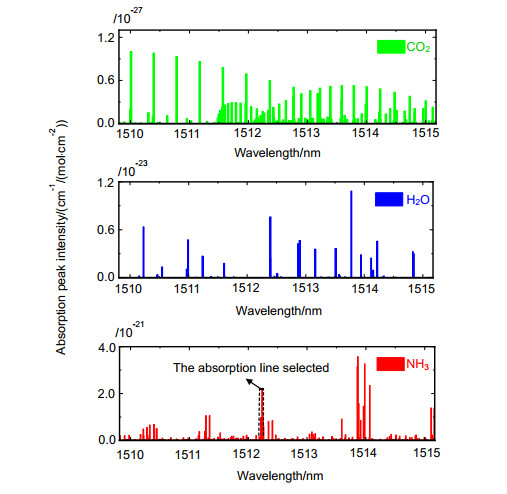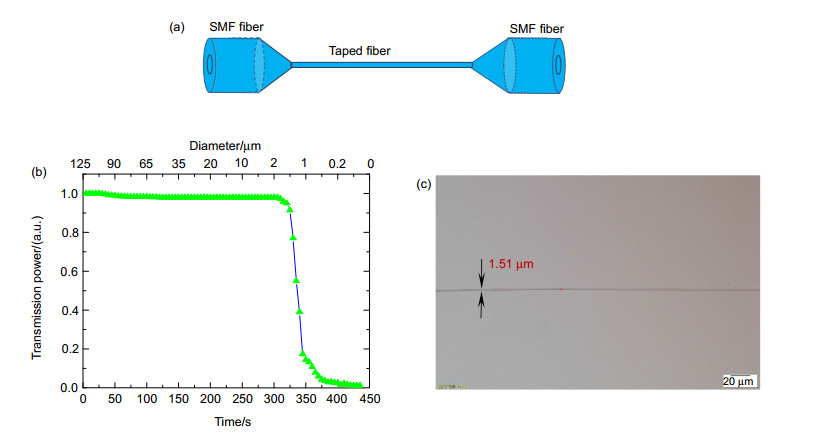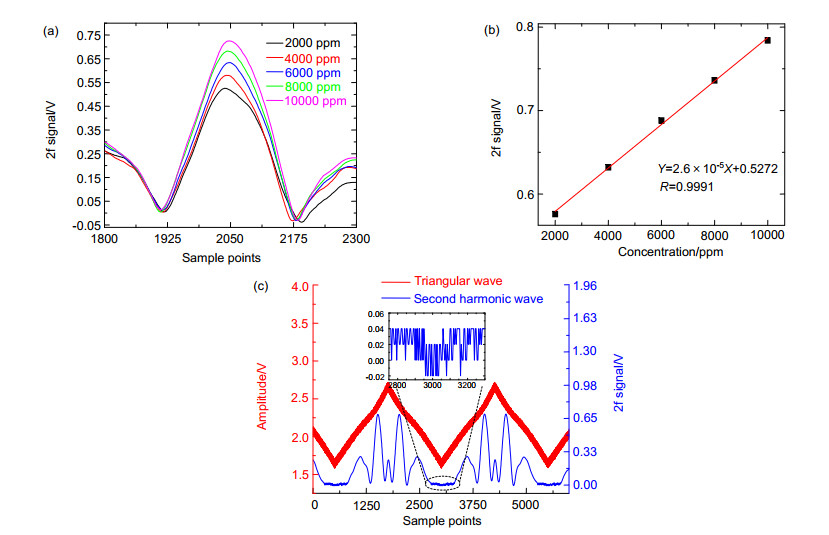Research on evanescent field ammonia detection with gold-nanosphere coated microfibers
-
摘要:
本文基于TDLAS技术,采用设计制备的微纳光纤气体吸收池,搭建了一套全光纤的NH3浓度检测系统。NH3检测系统的核心部分气体传感通过1.51 μm的微纳光纤完成,该系统检测结果表明,NH3在20000 ppm~100000 ppm浓度范围内,解调的二次谐波幅值与对应浓度之间具有良好的线性关系(拟合方程相关系数R=0.9962)。为了提高NH3浓度的检测性能,采用纳米金涂覆微纳光纤以增强光纤的倏逝场效应。根据实验结果,纳米金涂覆后的微纳光纤NH3浓度检测系统灵敏度有了很大提升,NH3浓度的检测下限可达到260 ppm。对不同浓度的NH3反复监测显示该检测系统稳定性良好,最大相对误差为5.38%,适用于长期稳定性的NH3监测,具有广泛的应用前景。
 Abstract:
Abstract:In this paper, based on TDLAS technology, an all-fiber NH3 concentration detection system was built by using the designed microfiber gas absorption cell. The core part of the NH3 detection system was sensed by a 1.51 μm microfiber. The test results of the system indicate that there is a good linear relationship between the second harmonic amplitude and the corresponding concentration for NH3 in the concentration range of 20000 ppm~100000 ppm (correlation coefficient of fitting formula R=0.9962). To improve the detection performance of NH3 concentration, the gold-nanosphere (GNS) coated microfiber is used to enhance the evanescent field effect. According to the experimental results, the sensitivity of the microfiber coated GNSs NH3 concentration detection system has been greatly improved and the lower detection limit of NH3 concentration can reach 260 ppm. Repeated monitoring of different concentrations of NH3 shows that the detection system is stable with a maximum relative error of 5.38%, which makes it suitable for long-term stable NH3 monitoring and has wide application prospects.
-
Key words:
- technology of TDLAS /
- microfiber /
- gold-nanosphere coating /
- NH3 concentration detection
-

Overview: Tunable diode laser absorption spectroscopy (TDLAS) is a highly sensitive laser absorption spectrum measurement technology, which determines the information of target gas by detecting the absorption intensity of the spectrum. With high selectivity, high sensitivity, rapid detection and high precision, it has been widely used in the real-time and online detection of atmospheric trace and polluted gases. However, most of gas absorption cells used in the existing detection system are based on the reflected spatial light structure, which requires the cooperation of the collimator with high precision. The structure of gas absorption cells is complex, expensive and bulky. On the other side, the optical fiber gas sensor based on fiber evanescent field is a neoteric kind of technology, and thus it takes light to measure the signal of the carrier and can adapt to various environments. Moreover, the evanescent field based optical fiber by coating various nanomaterials can improve the sensitivity of gas sensing, which has attracted wide attention.
In this paper, combined with TDLAS technology and gas sensing based on the evanescent field fiber, a set of all-fiber NH3 concentration detection system was built. The light source is a distributed feedback laser at around 1512 nm and the laser controller is modulated to select the unique absorption spectrum of NH3 to reduce the interference of carbon dioxide, vapor and other trace gases. A small gas absorption cell consists of a tapered microfiber with a 1.51 μm diameter. The microfiber was pulled into a cone by hydrogen and oxygen flame technology, and the second harmonic signal was finally extracted by a lock-in amplifier. The experimental results verified the feasibility of the evanescent field gas absorption cell, which is applied in the TDLAS system to detect ammonia gas. There was a good linear relationship between the amplitude of the second harmonic and the corresponding concentration in the range of 20000 ppm~100000 ppm of NH3. To improve the detection performance of NH3 concentration, gold-nanosphere (GNS) coated microfiber was used to enhance the effect of fiber evanescent fields. Compared with the measurement results of the evanescent field and GNSs coated microfiber, the detection sensitivity of the coated evanescent field significantly improved. Meanwhile, the TDLAS detection system based on GNSs coated microfibers as the evanescent-field based fiber gas absorption cell has good stability with the maximum relative error of 5.38%, and the detection limit of NH3 concentration can reach 260 ppm. The system has a wide application prospect in the field of ammonia detection.
-

-
图 3 激光器输出特性。(a) 驱动电流从30 mA至70 mA的激光器输出光谱,温度为25 ℃; (b) 激光器随工作温度的变化输出光谱,电流为50 mA; (c) 不同温度和不同电流时,输出波长对应曲线; (d) 不同驱动电流对应的激光器输出功率与加载电压
Figure 3. The characteristic of laser output. (a) The output spectrum of the laser when the driving current is adjusted from 30 mA to 70 mA, and the operating temperature is 25 ℃; (b) The output spectrum of laser with the change of working temperature, and the driving current is 50 mA; (c) The output wavelength corresponds to the curve at different temperature and current; (d) The output power and loading voltage of laser with different driving current
图 5 微纳光纤在(a) GNSs涂覆之前和(b) GNSs涂覆之后的倏逝场辐射; (c) 微纳光纤表面沉积GNSs的SEM图像,插入的是一段沉积GNSs的微纳光纤
Figure 5. The evanescent field radiation of the microfiber before (a) and after (b) GNSs deposition; (c) SEM image of the GNSs deposited on the surface of the microfiber. The insertion is a segment of the microfiber deposited by GNSs
图 7 (a) GNSs涂覆后微纳光纤气体吸收池不同NH3浓度时的二次谐波信号; (b) 二次谐波信号幅值与NH3浓度的实测数据和线性拟合曲线; (c) 浓度为6000 ppm的NH3的吸收波形及其对应的二次谐波(小图为无吸收处的噪音)
Figure 7. (a) 2f signals at different NH3 concentrations in the microfiber gas absorption pool after GNSs coating; (b) The measured data and linear fitting curve of the 2f signal's amplitude versus NH3 concentration; (c) The absorption waveform of NH3 with concentration of 6000 ppm and its corresponding second harmonic wave (the small figure is the noise without absorption)
表 1 系统稳定性测量结果
Table 1. The measurement results of system stability
Serial number Amplitude/V True concentration/ppm Measured concentration/ppm Absolute error/ppm Relative error/% 1 0.578 2000 1954 -46.15 -2.31 2 0.582 2000 2107 107.69 5.38 3 0.636 4000 4185 184.62 4.62 4 0.628 4000 3877 -123.08 -3.08 5 0.684 6000 6031 30.77 0.51 6 0.690 6000 6262 261.54 4.36 7 0.734 8000 7954 -46.15 -0.58 8 0.730 8000 7800 -200 -2.50 9 0.788 10000 10031 30.77 0.31 10 0.796 10000 10338 388.46 3.38 -
[1] 包景岭, 李伟芳, 邹克华. 浅议恶臭污染的健康风险研究[J]. 城市环境与城市生态, 2012, 25(4): 5-7.
Bao J L, Li W F, Zou K H. Research status of health risk of odor pollution[J]. Urban Environ Urban Ecol, 2012, 25(4): 5-7.
[2] Song X M, Liu J G, Zhang Y J, et al. Study of remote sensing the flux of carbon dioxide gas with tunable diode laser absorption spectroscopy[J]. Spectrosc Spect Anal, 2011, 31(3): 803-807.
[3] Kan R F, Liu W Q, Zhang Y J, et al. Large scale gas leakage monitoring with tunable diode laser absorption spectroscopy[J]. Chin Opt Lett, 2006, 4(2): 116-118.
[4] 姚路, 刘文清, 刘建国, 等. 基于TDLAS的长光程环境大气痕量CO监测方法研究[J]. 中国激光, 2015, 42(2): 0215003.
Yao L, Liu W Q, Liu J G, et al. Research on open-path detection for atmospheric trace gas CO based on TDLAS[J]. Chin J Lasers, 2015, 42(2): 0215003.
[5] 李明星, 刘建国, 阚瑞峰, 等. 基于可调谐半导体激光吸收光谱的CO和CH4实时检测系统设计[J]. 光学学报, 2015, 35(4): 0430001.
Li M X, Liu J G, Kan R F, et al. Design of real-time measurement of atmospheric CO and CH4 based on tunable diode laser spectroscopy system[J]. Acta Opt Sinica, 2015, 35(4): 0430001.
[6] Guo X Q, Zheng F, Li C L, et al. A portable sensor for in-situ measurement of ammonia based on near-infrared laser absorption spectroscopy[J]. Opt Laser Eng, 2019, 115: 243-248. doi: 10.1016/j.optlaseng.2018.12.005
[7] Tombez L, Zhang E J, Orcutt J S, et al. Methane absorption spectroscopy on a silicon photonic chip[J]. Optica, 2017, 4(11): 1322-1325. doi: 10.1364/OPTICA.4.001322
[8] Cui Y, Shum P P, Wang G H, et al. Size effect of gold nanoparticles on optical microfiber refractive index sensors[C]//Sensors, 2011: 371-374.
[9] Peng Z M, Ding Y, Lu C, et al. Calibration-free wavelength modulated TDLAS under high absorbance conditions[J]. Opt Express, 2011, 19(23): 23104-23110. doi: 10.1364/OE.19.023104
[10] Paynter R W. Modification of the Beer-Lambert equation for application to concentration gradients[J]. Surf Interface Anal, 1981, 3(4): 186-187. doi: 10.1002/sia.740030410
[11] Xu L G, Liu N W, Zhou S, et al. Dual-frequency modulation quartz crystal tuning fork enhanced laser spectroscopy[J]. Opt Express, 2020, 28(4): 5648-5657. doi: 10.1364/OE.386205
[12] Zhu M W, Zhang F, Li W W, et al. The impact of various HITRAN molecular spectroscopic databases on infrared radiative transfer simulation[J]. J Quant Spectrosc Radiat Transfer, 2019, 234: 55-63. doi: 10.1016/j.jqsrt.2019.04.031
[13] Rothman L S, Gordon I E, Babikov Y, et al. The HITRAN2012 molecular spectroscopic database[J]. J Quant Spectrosc Radiat Transfer, 2013, 130: 4-50.
[14] Tong L M, Lou J Y, Mazur E. Single-mode guiding properties of subwavelength-diameter silica and silicon wire waveguides[J]. Opt Express, 2004, 12(6): 1025-1035. doi: 10.1364/OPEX.12.001025
[15] Li Y H, Gong J, He G H, et al. Enhancement of photoresponse and UV-assisted gas sensing with Au decorated ZnO nanofibers[J]. Mater Chem Phys, 2012, 134(2-3): 1172-1178. doi: 10.1016/j.matchemphys.2012.04.014
[16] Li J D, Du Y J, Peng Z M, et al. Measurements of spectroscopic parameters of CO2 transitions for Voigt, Rautian, galatry and speed-dependent voigt profiles near 1.43µm using the WM-DAS method[J]. J Quant Spectrosc Radiat Transfer, 2019, 224: 197-205. doi: 10.1016/j.jqsrt.2018.11.014
[17] Pogány A, Wagner S, Werhahn O, et al. Development and metrological characterization of a tunable diode laser absorption spectroscopy (TDLAS) spectrometer for simultaneous absolute measurement of carbon dioxide and water vapor[J]. Appl Spectrosc, 2015, 69(2): 257-268. doi: 10.1366/14-07575
-


 E-mail Alert
E-mail Alert RSS
RSS

 下载:
下载:









